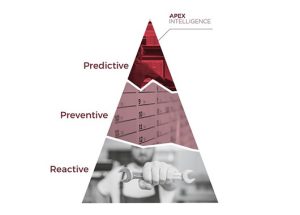The dilemma: whether or not is it possible to reduce both costs and risks? What the world will choose in 2020-2026?
Wrong system maintenance strategy may in principle determine overall productivity of the organization. No matter whether it is a manufacturing company, a real estate developer or a shopping centre. Everyone has the same dilemma to solve: how to maintain a balance between costs/expenses that are allocated to system maintenance and risk of failure, production downtime, inappropriate comfort, complaints or waste of energy resources. All this can be called the impact of system/building maintenance service. Maintenance service itself determines up to 30% of the overall productivity of the building or maintenance process.
New cost-reducing maintenance model
Maintenance and service models
The market for the predictive maintenance model is expanding globally at an annual rate of 25.2% from USD 4 billion in 2020 to a projected USD 12.3 billion in 2025. Such expansion is not accidental. Based on the global practice, the predictive maintenance model is up to 30% more efficient compared to other two system/building maintenance models – reactive and preventive. Let us examine the use, benefits and advantages of these 3 models.

III. Model – Predictive
Analytical data processing. Insights that can help predict equipment failures and verify service actions.
II. Model – Preventive
Scheduled performance of service works. Management/monitoring of engineering systems and data collection.
I. Model – Reactive
Accidents and repairs. Emergency response.
APEX Intelligence – APEX Intelligence – purposeful data traffic collection, analysis and management.
The use of equipment until the failure thereof is described as a reactive maintenance model. It is used for certain systems/equipment, the failure of which cannot lead to significant losses. For example, it is obvious that failure of one luminaire does not pose significant risks or potential loss. Usually, no special checks or inspections are required for luminaire to operate. In such cases, a reactive maintenance model is used.
However, there are systems whose malfunctioning may lead to significant losses or risks. For example, the operation of a fire alarm requires periodic inspections and tests. The scheduled preventive checks-inspections of systems are used for that purpose. The same is true for the lighting system. Imagine that if a lighting control time relay, which is responsible for switching off the light during non-working hours, does not work, failure of this system can already lead to up to 10% higher electricity consumption. Consequently, scheduled inspections for a part of this system may reduce waste of energy resources.
Up to 8 different systems or hundreds of different devices may simultaneously operate in the building. Therefore, an appropriate maintenance model needs to be adapted for each system not only for us to be able to ensure the requirements of Lithuanian legislation but also that we could make good use of the productivity of building systems by eliminating risks or losses of energy consumption. For example, heating, ventilation and air conditioning (HVAC) systems in the building account of up to 40% of energy costs. In addition, the operation of these systems ensures by 100% the comfort of people who are present in the building. Nevertheless, the reactive maintenance model or insufficient periodicity of scheduled inspections is incorrectly applied to the maintenance of these systems.
Naturally, an inspection of the HVAC system 365 times a year, when calculating wages, would cost a lot. Therefore, despite the importance of the proper system operation, the number of periodic inspections is reduced. Verification of the operation of these systems using digitization technologies is the only effective way to maintain a balance between the costs of maintenance and the impact of the service provided – comfort and optimal energy costs.
So, application of digitization for equipment maintenance is the essence of predictive maintenance which reduces the cost of maintenance itself and ensures efficient 24/7 operation of equipment.
What is the situation in Lithuania?
In Lithuania, up to 90% of organizations use reactive and preventive maintenance models in formulating a system maintenance strategy. Efforts are made to balance between minimum costs and requirements defined in the state acts. Lithuania, however, still lags behind the practice of other countries, where the third maintenance model – the model of predictive maintenance, that was mentioned above, is becoming particularly popular.
Sometimes we do not realize that the predictive maintenance model can already be used today in the majority of buildings without significant investment. Investment in building automation has been growing in the past 10 years. Therefore, the data collected about buildings can be easily used for more efficient system maintenance.
“APEX Intelligence”, an independent data analytics centre founded by “City Service Engineering”, ensures efficient collection and use of building data and the predictive performance of maintenance.
The professionals of “City Service Engineering“ can perform system digitization analysis in your building and provide suggestions on how to optimize building maintenance.

